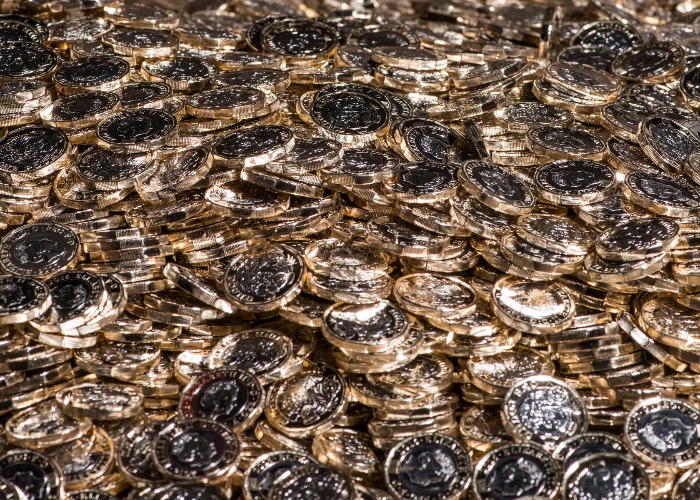New £1 coin: where to get one, security features and how it's made

The new £1 coin is released today (28 March). We reveal where you can get one, highlight the new security features and explain how it's made behind the scenes at the Royal Mint.
The new 12-sided £1 coin comes into circulation today (28 March). Here's everything you need to know.
Where can I get the new £1 coin?
The Royal Mint says around 300 million of the new £1 coins have been distributed to cash centres across the UK.
It’ll probably be a few days before these coins filter through to stores and become available at the tills.
If you want to get your hands on one today, you’ll need to visit one of the 33 banks and post offices situated across the UK that already stock the coins.
New ‘hidden’ security feature
The Royal Mint has described the new £1 as the most secure coin in the world.
That’s partly down to a ‘hidden’ security feature that makes it more difficult to counterfeit.
This is believed to involve a material inside the coin itself, which can only be detected when electronically scanned by payment machines.
How is the new £1 coin made?
I visited to the Royal Mint in Llantrisant to find out how the remarkable new coins are made – and to snap a few photos of the process.

Everything is done on-site, from burning the metals to engraving to striking to the final quality check before they leave the Mint.
Commemorative coins and bullion are also made on another part of the site.
First things first
Coin production begins by making the blanks. Metals for the £1 coin are melted down in a massive furnace and then removed as a continuous strip. It can weigh up to 2.8 tonnes.
This strip is passed through rolling mills to reduce it to coin thickness. After that, blank discs of metal are punched from the strip in a blanking press, producing up to 10,000 blanks a minute.

Blanks are softened by heating them in an annealing furnace at up to 950C. They’re cleaned to make sure they’re blemish-free.
Once the design is approved, a plaster model measuring several times the diameter of the £1 coin is made.
The plaster model is scanned by a ruby-tipped probe which records the design as a digital file on a computer. An engraving machine cuts the design into a piece of steel at the correct size of the coin, based on the digital file.

This piece of steel is then used to make the dies which will actually strike the coins. It’s known as a reduction punch.
Striking!
The coin press room is where the final part of the process, the striking, takes place.
Staff at the Royal Mint have been working 24 hours a day since the beginning of March to get a massive 1.5 billion pound coins ready by today (28 March).
The coins are fed into the coin press which ‘strikes’ the dies on to the blanks, applying a pressure of around 60 tonnes. Check out this example of a commemorative £1 coin going into the press.

The coins then go into the tote box for quality control. You can see Hywel Price, the Royal Mint’s circulating coin press setter, doing checks here.

He’s looking for imperfections like the outside ring being worn out.

Once the coins have got the OK, they’re released into the still box ready to be taken away to ‘cash centres’ across the UK. That’s where they’ll stay before they get circulated.

The coins are literally ‘hot off the press’ – it’s surprising how warm they are.

There are 10 presses on the go at any one time, and the Mint is producing 3 million £1 coins a day: that’s 140,000 an hour and eight or nine coins a second. When I visit, they’re right on track to meet their deadline.

Getting them out there
The biggest challenge isn’t working tirelessly around the clock to create the coins; there are actually bigger concerns about distribution.
“It’s time-consuming” says technical manager, Scott Kuperus. A lot of talks have been taking place with operators of car parks, gyms, vending machines and others who use £1 coins, to help them adjust to the new coins.
“There’s no other product that everybody – children, old people, low earners, high earners – will be in contact with,” says Kuperus.
Catching out the counterfeiters
The Mint reckons that one in 30 ‘round pound’ coins are now counterfeit.
Minting technology has come on significantly since £1 coins were introduced in 1983, and the availability of materials is much wider, so counterfeiting is more common than it is used to be.
“It can be everything from one man in a shed to larger counterfeit operations,” says Kuperus.
“They only have to pass it off once.”

The 12-sided coins are bi-metallic and have micro-lettering, milled edges and hidden high security features, which are used in bank notes.
They’re said to be the most secure coins in the world. The £1 coin was about due for modernisation anyway; it has to be suitable for the next 20-30 years.
“Dig in to your jam jars, down the back of the couch, your glove compartment, anywhere you can think of, before they expire on 15 October,” says Kuperus.
And what will happen to the ‘round pound’ coins, you ask? They’ll be re-used by melting them down into the new coins.

Boost your finances with a high interest current account
More on the new £1 coin:
Will the new £1 coin be a nightmare to spend?
Comments
Be the first to comment
Do you want to comment on this article? You need to be signed in for this feature